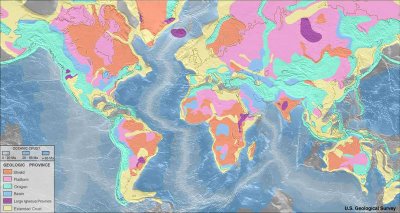C
Cratons ▫ Laurentian Craton | 0 Guide-Glossary
Definitions and images to illustrate geological terms, links to images and website articles
Labels: akmolith, cactolith, chonolith, ductolith, ethmolith, harpolith, sphenolith
Labels: batholith, bysmolith, coastline, concordant, conformable, dike, discordant, laccolith, river system, sill, vein
 Cratons, or continental platforms are the ancient, stable geological provinces at the core of continents (orange in image at left). Cratons have peristed for more than 500 million years (some over 2 billion years).
Cratons, or continental platforms are the ancient, stable geological provinces at the core of continents (orange in image at left). Cratons have peristed for more than 500 million years (some over 2 billion years).Labels: Archean, Baltic Shield, crystalline basement, felsic, Hadean, Interior platform, North American craton, proto-continents
Labels: cryoseism, frost quake, ice quake, non-tectonic, seismic event, stress